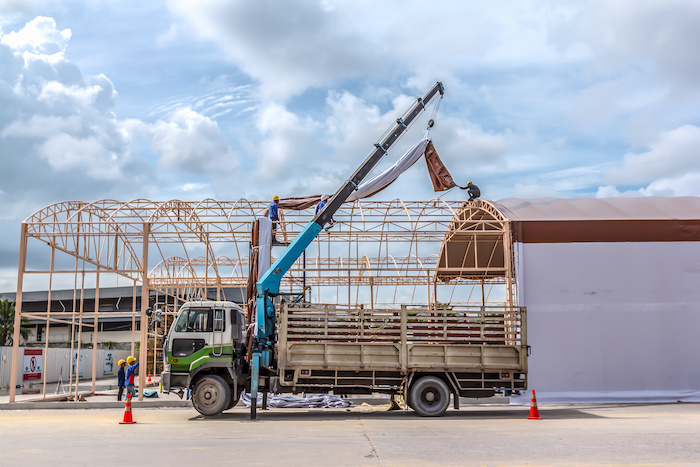
Since fabric buildings are tensile structures, the membrane can be pulled into a three-dimensional surface for developing shading, a roof, or a decorative component. Simply put, they’re a building made of all-steel frames and tarp covers or fabric material. They’re designed with lightweight materials, unlike permanent buildings that are normally composed of steel, bricks, lumber or other materials. However, they boast strong protection from weather elements and provide storage space.
Moreover, they’re known as modern tents that are portable and fast to build, which is why they’re ideal for temporary purposes. For instance, you can construct fabric structures for mining operations and storage equipment for landscaping, construction, and automotive businesses. They can even be used as meeting spaces or offices—all you have to do is include electricity. Aside from these applications, fabric structures make for great workshop spaces for masonry, carpentry, manufacturing, or agriculture.
Read on to learn about the advantages of fabric buildings.
1. They’re Cost-Effective
Fabric buildings are cost-effective, as they require less expensive materials that are put together in a short time. Because they’re easy and quick to install, they lower labor costs. What’s more, they don’t need a building permit, allowing you to maximize time, as well as save on cost.
2. They Offer Ventilation
Fabric buildings come with a high roof design, leading to a large volume of interior air space. This design makes them especially beneficial for agricultural purposes: Warm moist air is raised and kept away from machinery, commodities, livestock, or equipment. Since they can provide end wall ventilation, roof ventilation, and side ventilation, they’re able to release not only warm moist air but also odors.
They’re advantageous for industrial, commercial, and retail uses too. They enhance control and air management with their non-permeable fabric cover and make installing ventilation and heating or cooling systems a breeze.
3. They’re Simple To Reconstruct
Since fabric buildings aren’t permanent, they’re convenient for necessary changes in a facility. You can simply reconstruct a fabric structure when the need arises. For instance, if you need more space for parking cars, you can expand the frame and adjust it to create more space that can accommodate more cars.
4. They’re Durable And Safe
When properly constructed and well-protected from vandalism and falling objects, fabric buildings are sturdy and long-lasting. They’re made of a material that’s resistant to corrosion. So, they can be used to organize and store corrosive materials. In fact, they can withstand any environmental conditions if you pair fabric with solid steel I-beams.
Furthermore, they help prevent accidents and injuries, for they’re made of translucent material that invites natural light into buildings, and they keep heat away by deflecting the sun’s rays.
5. They’re Energy-Efficient
Fabric buildings are energy-efficient. As mentioned earlier, they’re built with lightweight materials, which reduces the cost of fuel to transport them to the site. Besides, they don’t need concrete for their foundation, which lets you save on high energy usage and costs that usually come with traditional construction.
6. They Require Less Time To Construct
Fabric structures can be constructed in just weeks, in contrast to steel or wood buildings that take months to build. Apart from fast construction, they feature parts that can be assembled together easily, so it doesn’t need a lot of manpower.
7. They’re Lightweight
Another advantage of their lightweight nature is that they can cover large areas and develop space free of columns. They call for less structural steel support too. Thus, they’re ideal for structures, like shopping centers, auditoriums, and sports facilities.
8. They’re Composed Of Recyclable Materials
Once their purpose has been achieved, you can recycle their materials. Metal stud walls and cables are usually reused for another purpose.
9. They’re Designed For Flexibility
Fabric buildings are constructed for various uses, including warehouses, garages, and greenhouses. They can be designed to have additional options, like door systems, insulation, electrical and lighting systems, and rolling systems for tracks.
Because they can be set up anywhere, you can put up a greenhouse instead of abandoning a space that’s not suitable for construction. With a greenhouse set up easily, you can grow food.
10. They Provide An Open And Pillar-Free Space
It’s possible to construct a fabric building 80 meters wide, with no pillars and columns inside. The ample and undivided space allows you to carry out multiple operations and use it for mass storage of equipment.
11. They Promote Good Health
Fabric buildings promote good health by lowering humidity levels and inhibiting the growth of mold and bacteria. One of the materials used to construct fabric buildings is polyethylene, which is weather-resistant. It has a fungicide-resistant coating that keeps mold from growing, especially in areas with long periods of rainy weather and humid conditions.
Therefore, fabric buildings offer a safe environment for not only people with allergies or asthma but everyone as well.
Conclusion
Fabric buildings are beneficial for a number of purposes, such as agriculture and retail. What makes them even better than traditional, permanent buildings is that they’re environmentally friendly.
